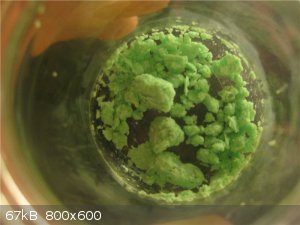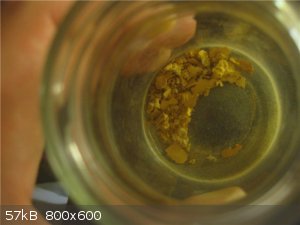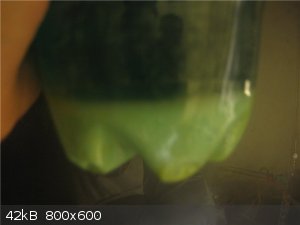| Pages:
1
2 |
Romix
Hazard to Others (Literally)
  
Posts: 427
Registered: 19-6-2015
Member Is Offline
Mood: No Mood
|
|
Light blue hydroxide
Hello Dear forum members, please help me identify chloride salt.
Its anhydrous yellow.
Salt is very light, between green and blue.
With NaOH light blue hydroxide formed.
Same, with very diluted ammonia.
Not nickel, cos it should form complex with it.
No reduction with aluminium.
|
|
|
ave369
Eastern European Lady of Mad Science
   
Posts: 596
Registered: 8-7-2015
Location: No Location
Member Is Offline
Mood: No Mood
|
|
Might be some rare earth?
Smells like ammonia....
|
|
|
Romix
Hazard to Others (Literally)
  
Posts: 427
Registered: 19-6-2015
Member Is Offline
Mood: No Mood
|
|
white with light blue tint
|
|
|
Romix
Hazard to Others (Literally)
  
Posts: 427
Registered: 19-6-2015
Member Is Offline
Mood: No Mood
|
|
Will decompose sample of it, to oxide, I let you know colour later. And flame.
|
|
|
Bert
|
Thread Moved
26-12-2015 at 05:54 |
Romix
Hazard to Others (Literally)
  
Posts: 427
Registered: 19-6-2015
Member Is Offline
Mood: No Mood
|
|
Its oxide is grey.
[Edited on 26-12-2015 by Romix]
|
|
|
Romix
Hazard to Others (Literally)
  
Posts: 427
Registered: 19-6-2015
Member Is Offline
Mood: No Mood
|
|
Which one? maybe neodium?
|
|
|
Romix
Hazard to Others (Literally)
  
Posts: 427
Registered: 19-6-2015
Member Is Offline
Mood: No Mood
|
|
Chloride salt

Anhydrous

Hydroxide, with NaOH solution became colourles after nuetralization, with ammonia solution still green after all light blue unknown to me hydroxide
precipitated, that's it on picture. Not forming complex.

Decomposed sample of it, to grey oxide, which is non-magnetic.
Please help.
[Edited on 1-1-2016 by Romix]
|
|
|
The Volatile Chemist
International Hazard
    
Posts: 1981
Registered: 22-3-2014
Location: 'Stil' in the lab...
Member Is Offline
Mood: Copious
|
|
Perhaps some clarity as to source, method of acquisition (not necessary, helpful though). Do the stoichiometry of mass change when the grey oxide is
formed, that may or may not be helpful.
Possibly this?
https://en.wikipedia.org/wiki/Praseodymium%28III%29_chloride
Fits your oxide identification:
https://www.google.com/search?q=Praseodymium%28III%29+oxide&...
|
|
|
Romix
Hazard to Others (Literally)
  
Posts: 427
Registered: 19-6-2015
Member Is Offline
Mood: No Mood
|
|
And yea, happy new year to all you dear forum members.
|
|
|
The Volatile Chemist
International Hazard
    
Posts: 1981
Registered: 22-3-2014
Location: 'Stil' in the lab...
Member Is Offline
Mood: Copious
|
|
Indeed, it's a new year just now for me. Does my suggestion above fit the compound? Perhaps do some more testing.
|
|
|
Romix
Hazard to Others (Literally)
  
Posts: 427
Registered: 19-6-2015
Member Is Offline
Mood: No Mood
|
|
Testing? How?
[Edited on 1-1-2016 by Romix]
|
|
|
The Volatile Chemist
International Hazard
    
Posts: 1981
Registered: 22-3-2014
Location: 'Stil' in the lab...
Member Is Offline
Mood: Copious
|
|
Well, I find it likely it's Praseodymium(III) Chloride. Perhaps you should look up some properties of praseodymium(III) ions and see if you can figure
it out  Don't leave all the science to other members! Don't leave all the science to other members!
|
|
|
Romix
Hazard to Others (Literally)
  
Posts: 427
Registered: 19-6-2015
Member Is Offline
Mood: No Mood
|
|
Quote: Originally posted by The Volatile Chemist  | Well, I find it likely it's Praseodymium(III) Chloride. Perhaps you should look up some properties of praseodymium(III) ions and see if you can figure
it out  Don't leave all the science to other members! Don't leave all the science to other members! |
Can be, how you know?
[Edited on 17-4-2016 by Romix]
|
|
|
Romix
Hazard to Others (Literally)
  
Posts: 427
Registered: 19-6-2015
Member Is Offline
Mood: No Mood
|
|
At the start it's purple, then colorless.
Valency change?
Then turning green, possibly nickel starting oxidizing, or reacting with solution.
Carbonate and hydroxide. same colour.
[Edited on 17-4-2016 by Romix]
|
|
|
Romix
Hazard to Others (Literally)
  
Posts: 427
Registered: 19-6-2015
Member Is Offline
Mood: No Mood
|
|
Titanium is other way roud, first it's green, then oxidizing to purple.
Ti? When green, green drops, when purple, pink-purple, when precipitated with base.
[Edited on 17-4-2016 by Romix]
|
|
|
Romix
Hazard to Others (Literally)
  
Posts: 427
Registered: 19-6-2015
Member Is Offline
Mood: No Mood
|
|
Iron is brown when in II state and green in third. As written in books, it's true.
When standing on air, green oxidising to brown. Happens quick.
[Edited on 17-4-2016 by Romix]
|
|
|
Romix
Hazard to Others (Literally)
  
Posts: 427
Registered: 19-6-2015
Member Is Offline
Mood: No Mood
|
|
Quote: Originally posted by Romix  | Iron is green when in II state and brown in third. As written in books, it's true.
When standing on air, green oxidising to brown. Happens quick.
[Edited on 17-4-2016 by Romix] |
|
|
|
bolbol
Hazard to Others
  
Posts: 167
Registered: 3-1-2015
Member Is Offline
Mood: No Mood
|
|
The only chloride I can think of with that smiliar color are copper, nickel, and praseodymium chlorides. Are you sure it is a pure sample?
|
|
|
Texium
Administrator
       
Posts: 4516
Registered: 11-1-2014
Location: Salt Lake City
Member Is Offline
Mood: PhD candidate!
|
|
We need more information, such as where it came from. For all we know you found this laying in the street. Where did you get it, and are you sure it's
a pure compound?
|
|
|
Romix
Hazard to Others (Literally)
  
Posts: 427
Registered: 19-6-2015
Member Is Offline
Mood: No Mood
|
|
No. dirty. Ceramics of dissolved capasitors.
In first valency it were purple.
Collected more of this, jar full of it.
Yes there could be nickel present in it.
And tin, I'll try to remove it on the next wash up.
[Edited on 15-8-2016 by Romix]
|
|
|
NEMO-Chemistry
International Hazard
    
Posts: 1559
Registered: 29-5-2016
Location: UK
Member Is Offline
Mood: No Mood
|
|
could it be tantalum? some small ceramic capacitors contain Tantalum, but i know nothing of its chemistry.
|
|
|
Romix
Hazard to Others (Literally)
  
Posts: 427
Registered: 19-6-2015
Member Is Offline
Mood: No Mood
|
|
No, doubt it. Tantalum is in yellow and black plastic case capacitors, wire inside and oxides. These are MLCC. With nickel plates inside.
And I tried boiling Ta2O5 in muriatic acid and caustic soda, none of it dissolved.
There could be anything, all removed from different brand boards, and years vary.
[Edited on 16-8-2016 by Romix]
|
|
|
Romix
Hazard to Others (Literally)
  
Posts: 427
Registered: 19-6-2015
Member Is Offline
Mood: No Mood
|
|
Does look like Sn+*, but not tin.
[Edited on 14-9-2016 by Romix]
|
|
|
MrHomeScientist
International Hazard
    
Posts: 1806
Registered: 24-10-2010
Location: Flerovium
Member Is Offline
Mood: No Mood
|
|
Sounds a lot like copper chloride to me. Anhydrous is brown, hydrated chloride is green, hydroxide is blue. The grey oxide doesn't fit, since it
should be black, but maybe there was incomplete decomposition. How hot did you heat it, and for how long?
|
|
|
crystal grower
Hazard to Others
  
Posts: 474
Registered: 3-1-2016
Location: Os Petrosum
Member Is Offline
Mood: Puzzled
|
|
Quote: Originally posted by MrHomeScientist  | | Sounds a lot like copper chloride to me. Anhydrous is brown, hydrated chloride is green, hydroxide is blue. The grey oxide doesn't fit, since it
should be black, but maybe there was incomplete decomposition. How hot did you heat it, and for how long? |
copper chloride is what came to my mind first (I've noticed this thread today as you posted this reply  ). ).
Try dissolving carbonate or hydroxide in sulfuric acid to see what colour does the sulfate is.
|
|
|
| Pages:
1
2 |